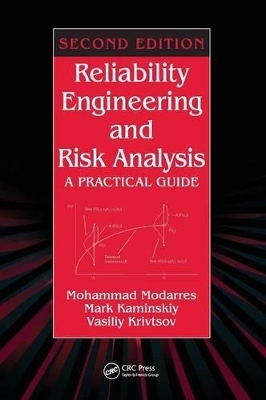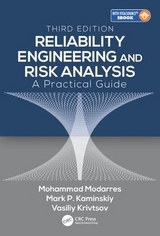
Reliability Engineering and Risk Analysis
Crc Press Inc
978-0-8493-9247-4 (ISBN)
- Titel erscheint in neuer Auflage
- Artikel merken
Tools to Proactively Predict Failure
The prediction of failures involves uncertainty, and problems associated with failures are inherently probabilistic. Their solution requires optimal tools to analyze strength of evidence and understand failure events and processes to gauge confidence in a design’s reliability.
Reliability Engineering and Risk Analysis: A Practical Guide, Second Edition has already introduced a generation of engineers to the practical methods and techniques used in reliability and risk studies applicable to numerous disciplines. Written for both practicing professionals and engineering students, this comprehensive overview of reliability and risk analysis techniques has been fully updated, expanded, and revised to meet current needs. It concentrates on reliability analysis of complex systems and their components and also presents basic risk analysis techniques. Since reliability analysis is a multi-disciplinary subject, the scope of this book applies to most engineering disciplines, and its content is primarily based on the materials used in undergraduate and graduate-level courses at the University of Maryland. This book has greatly benefited from its authors' industrial experience. It balances a mixture of basic theory and applications and presents a large number of examples to illustrate various technical subjects. A proven educational tool, this bestselling classic will serve anyone working on real-life failure analysis and prediction problems.
Mohammad Modarres is a professor of nuclear engineering and reliability engineering. His research areas are system reliability modeling, probabilistic risk analysis, probabilistic physics of failure, and uncertainty modeling and analysis. He is a consultant to several government and private organizations as well as national laboratories. Prof. Modarres has published more than 200 papers in professional journals and proceedings of conferences; three books; and a number of book chapters, edited books, and handbooks. He is a University of Maryland Distinguished Scholar-Teacher, a fellow of the American Nuclear Society, and has received a number of other awards in reliability engineering and risk assessment. Prof. Modarres received his PhD in nuclear engineering from the Massachusetts Institute of Technology (MIT) in 1979 and his MS in mechanical engineering from MIT in 1977. Mark Kaminskiy is the chief statistician at the Center of Technology and Systems Management, University of Maryland (College Park). Dr. Kaminskiy is a researcher and consultant in reliability engineering, life data analysis, and risk analysis of engineering systems. He has conducted numerous research and consulting projects funded by the government and industrial companies such as the Department of Transportation, the Coast Guard, the Army Corps of Engineers, the Navy, the Nuclear Regulatory Commission, the American Society of Mechanical Engineers, Ford Motor Company, Qualcomm Inc., and several other engineering companies. He has taught several graduate courses on reliability engineering at the University of Maryland. Dr. Kaminskiy is the author or coauthor of over 50 publications in journals, conference proceedings, and reports. Vasiliy Krivtsov is a senior staff technical specialist in reliability and statistical analysis with Ford Motor Company. He holds MS and PhD degrees in electrical engineering from Kharkov Polytechnic Institute, Ukraine, and a PhD in reliability engineering from the University of Maryland. Dr. Krivtsov is the author or coauthor of over 40 professional publications, including a book on reliability engineering and risk analysis, nine patented inventions, and three Ford trade secret inventions. He is an editor of Reliability Engineering and System Safety journal and is a member of the IEEE Reliability Society. Prior to Ford, Dr. Krivtsov held the position of associate professor of electrical engineering in Ukraine and that of a research affiliate at the Center for Reliability Engineering, University of Maryland. Further information on Dr. Krivtsov's professional activity is available at http://www.krivtsov.net.
Chapter 1 Reliability Engineering in Perspective
1.1 Why Study Reliability?
1.2 Failure Models
1.3 Failure Mechanisms
1.4 Performance Measures
1.5 Formal Definition of Reliability
1.6 Definition of Availability
1.7 Definition of Risk
Chapter 2 Basic Reliability Mathematics: Review of Probability and Statistics
2.1 Introduction
2.2 Elements of Probability
2.3 Probability Distributions
2.4 Basic Characteristics of Random Variables
2.5 Estimation and Hypothesis Testing
2.6 Frequency Tables and Histograms
2.7 Goodness-of-Fit Tests
2.8 Regression Analysis
Chapter 3 Elements of Component Reliability
3.1 Concept of Reliability
3.2 Common Distributions in Component Reliability
3.3 Component Reliability Model Selection
3.4 Maximum Likelihood Estimation of Reliability Distribution Parameters
3.5 Classical Nonparametric Distribution Estimation
3.6 Bayesian Estimation Procedures
3.7 Methods of Generic Failure Rate Determination
Chapter 4 System Reliability Analysis
4.1 Reliability Block Diagram Method
4.2 Fault Tree and Success Tree Methods
4.3 Event Tree Method
4.4 Master Logic Diagram
4.5 Failure Mode and Effect Analysis
Chapter 5 Reliability and Availability of Repairable Components and Systems
5.1 Repairable System Reliability
5.2 Availability of Repairable Systems
5.3 Use of Markov Processes for Determining System Availability
5.4 Use of System Analysis Techniques in the Availability Calculations of Complex Systems
Chapter 6 Selected Topics in Reliability Modeling
6.1 Probabilistic Physics-of-Failure Reliability Modeling
6.2 Software Reliability Analysis
6.3 Human Reliability
6.4 Measures of Importance
6.5 Reliability-Centered Maintenance
6.6 Reliability Growth
Chapter 7 Selected Topics in Reliability Data Analysis
7.1 Accelerated Life Testing
7.2 Analysis of Dependent Failures
7.3 Uncertainty Analysis
7.4 Use of Expert Opinion for Estimating Reliability Parameters
7.5 Probabilistic Failure Analysis
Chapter 8 Risk Analysis
8.1 Determination of Risk Values8.2 Formalization of Quantitative Risk Assessment
8.3 Probabilistic Risk Assessment
8.4 Compressed Natural Gas Powered Buses: A PRA Case Study
8.5 A Simple Fire Protection Risk Analysis
8.6 Precursor Analysis
Appendices
Index
| Erscheint lt. Verlag | 22.9.2009 |
|---|---|
| Zusatzinfo | 854; 64 Tables, black and white; 245 Illustrations, black and white |
| Verlagsort | Bosa Roca |
| Sprache | englisch |
| Maße | 178 x 254 mm |
| Gewicht | 1021 g |
| Themenwelt | Mathematik / Informatik ► Mathematik |
| Technik ► Maschinenbau | |
| Wirtschaft ► Betriebswirtschaft / Management ► Logistik / Produktion | |
| ISBN-10 | 0-8493-9247-0 / 0849392470 |
| ISBN-13 | 978-0-8493-9247-4 / 9780849392474 |
| Zustand | Neuware |
| Haben Sie eine Frage zum Produkt? |
aus dem Bereich



